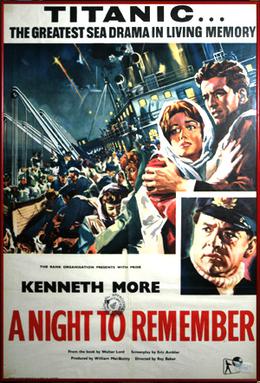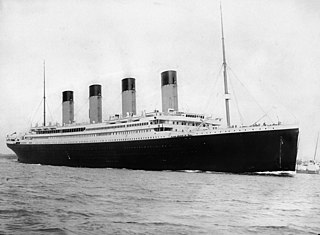
HMHSBritannic was the third and final vessel of the White Star Line's Olympic class of steamships and the second White Star ship to bear the name Britannic. She was the youngest sister of the RMS Olympic and the RMS Titanic and was intended to enter service as a transatlantic passenger liner. She was operated as a hospital ship from 1915 until her sinking near the Greek island of Kea, in the Aegean Sea, in November 1916. At the time she was the largest hospital ship in the world.

Thomas Andrews Jr. was a British businessman and shipbuilder. He was managing director and head of the drafting department of the shipbuilding company Harland and Wolff in Belfast, Ireland.

In Nacht und Eis, also called Der Untergang der Titanic and Shipwrecked in Icebergs in the US, is a 1912 German silent adventure-disaster drama film about the sinking of RMS Titanic. This is the second surviving film about the Titanic disaster.

Violet Constance Jessop was an Irish-Argentine ocean liner stewardess and nurse in the early 20th century. Jessop is most well known for having survived the sinking of both the RMS Titanic in 1912 and her sister ship the HMHS Britannic in 1916, as well as having been onboard the eldest of the three sister ships, the RMS Olympic, when it collided with the British warship HMS Hawke in 1911.

Titanic is a 1996 American two-part television miniseries which premiered on CBS on November 17 and 19, 1996. It focuses on several characters aboard the RMS Titanic during her maiden voyage in 1912. The miniseries was directed by Robert Lieberman. The original music score was composed by Lennie Niehaus.

Dorothy Gibson was an American actress, socialite and artist's model, active in the early 20th century. She survived the sinking of the Titanic and starred in the first motion picture based on the disaster.

Saved from the Titanic was a 1912 American silent short film starring Dorothy Gibson, an American film actress who survived the sinking of the RMS Titanic on April 15, 1912. Premiering in the United States just 31 days after the event, it was the earliest dramatization of the tragedy.

A Night to Remember is a 1958 British historical disaster docudrama film based on the eponymous 1955 book by Walter Lord. The film and book recount the final night of RMS Titanic, which sank on her maiden voyage after she struck an iceberg in 1912. Adapted by Eric Ambler and directed by Roy Ward Baker, the film stars Kenneth More as the ship's Second Officer Charles Lightoller and features Michael Goodliffe, Laurence Naismith, Kenneth Griffith, David McCallum and Tucker McGuire. It was filmed in the United Kingdom and tells the story of the sinking, portraying the main incidents and players in a documentary-style fashion with considerable attention to detail. The production team, supervised by producer William MacQuitty used blueprints of the ship to create authentic sets, while Fourth Officer Joseph Boxhall and ex-Cunard Commodore Harry Grattidge worked as technical advisors on the film. Its estimated budget of up to £600,000 was exceptional and made it the most expensive film ever made in Britain up to that time. The film's score was written by William Alwyn.

The Titanic has played a prominent role in popular culture since her sinking in 1912, with the loss of over 1,500 of the 2,200 lives on board. The disaster and the Titanic herself have been objects of public fascination for many years. They have inspired numerous books, plays, films, songs, poems, and works of art. The story has been interpreted in many overlapping ways, including as a symbol of technological hubris, as basis for fail-safe improvements, as a classic disaster tale, as an indictment of the class divisions of the time, and as romantic tragedies with personal heroism. It has inspired many moral, social and political metaphors and is regularly invoked as a cautionary tale of the limitations of modernity and ambition.
Frank "Lucky" Tower is the subject of an urban legend that said that he was a stoker who survived the sinking of RMS Titanic, RMS Empress of Ireland, and RMS Lusitania. There is no evidence that anyone was involved in all three disasters, and there was no one with the name of Frank Tower on the crew list on any of these vessels' respective voyages; however, there was one survivor and passenger named Frank Tower from Lusitania, and a William Clark who survived both the Titanic and Empress of Ireland sinkings.

RMS Titanic sank in the early morning hours of 15 April 1912 in the North Atlantic Ocean, four days into her maiden voyage from Southampton to New York City. The largest ocean liner in service at the time, Titanic had an estimated 2,224 people on board when she struck an iceberg at around 23:40 on Sunday, 14 April 1912. Her sinking two hours and forty minutes later at 02:20 ship's time on Monday, 15 April, resulted in the deaths of more than 1,500 people, making it one of the deadliest peacetime maritime disasters in history.

The Olympic-class ocean liners were a trio of British ocean liners built by the Harland & Wolff shipyard for the White Star Line during the early 20th century. They were Olympic (1911), Titanic (1912) and Britannic (1914). All three were designed to be the largest and most luxurious passenger ships at that time, designed to give White Star an advantage in the transatlantic passenger trade.

RMS Titanic was a British passenger and mail carrying ocean liner, operated by the White Star Line, that sank in the North Atlantic Ocean on 15 April 1912 as a result of striking an iceberg during her maiden voyage from Southampton, England, to New York City, United States. Of the estimated 2,224 passengers and crew aboard, about 1,500 died, making it the deadliest sinking of a single ship up to that time. The disaster drew public attention, spurred major changes in maritime safety regulations, and inspired many artistic works.

TitanicBelfast is a visitor attraction opened in 2012, a monument to Belfast's maritime heritage on the site of the former Harland & Wolff shipyard in the city's Titanic Quarter where the RMS Titanic was built. It tells the stories of the Titanic, which hit an iceberg and sank during her maiden voyage in 1912, and her sister ships RMS Olympic and HMHS Britannic. The building contains more than 12,000 square metres (130,000 sq ft) of floor space, most of which is occupied by a series of galleries, private function rooms and community facilities.

No Greater Love, also known as Danielle Steel's No Greater Love, is a 1996 American made-for-television romantic drama film directed by Richard T. Heffron. The film is based upon the 1991 novel of the same name written by Danielle Steel.

Titanic is a four-part television serial and period drama written by Julian Fellowes. It is based on the passenger liner RMS Titanic, which sank in the North Atlantic Ocean in April 1912 following a collision with an iceberg on her maiden voyage from Southampton to New York City.

Titanic Lifeboat No. 1 was a lifeboat from the steamship Titanic. It was the fifth boat launched to sea, over an hour after the liner collided with an iceberg and began sinking on 14 April 1912. With a capacity of 40 people, it was launched with only 12 aboard, the fewest to escape in any one boat that night.

Lifeboats played a crucial role during the sinking of the Titanic on 14–15 April 1912. The ship had 20 lifeboats that, in total, could accommodate 1,178 people, a little over half of the 2,209 on board the night it sank.

HMS Scourge was a Beagle-class destroyer, launched in 1910 and served in the Royal Navy. In 1913 she was transferred to the Third Destroyer Flotilla. She was used during the Gallipoli campaign to help transfer regiments to the shore at Anzac Cove and Suvla Bay. Subsequently, she assisted in the rescue of survivors from the sinking of HMHS Britannic.

Archie Jewell was an English sailor who was on the crew of the Titanic. He survived the sinking of the Titanic and Britannic, but died during the sinking of the SS Donegal when it was torpedoed without warning by German forces during the course of World War I.




















